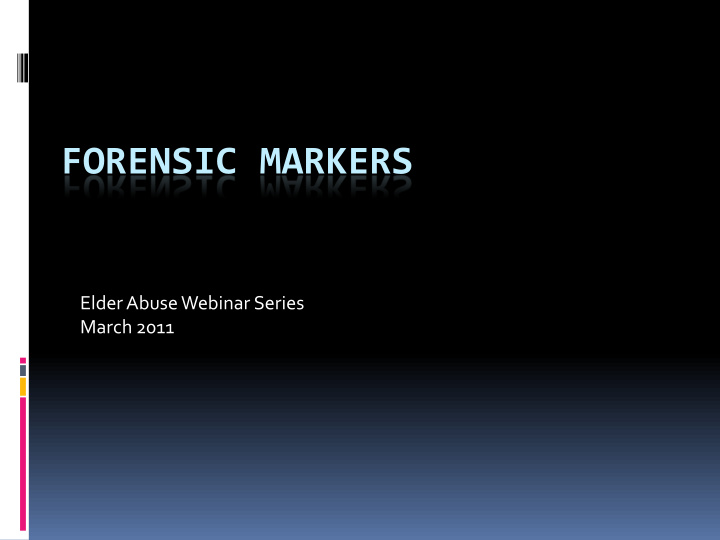



FORENSIC MARKERS Elder Abuse Webinar Series March 2011
Forensic Markers Bruises Fractures Head trauma Skin trauma: lacerations, abrasions Strangulation Pressure Sores
Bruising Study A survey of 101 seniors was conducted on a daily basis (up to 6 weeks) to document the occurrence, progression and resolution of accidental bruises that occurred during the observation period. The life cycle of bruises in older adults. J Am Geriatr Soc. 2005 Aug;53(8):1339-43.
Location of Bruises Posterior Anterior (108 bruises at Day 1)
Summary of Results 90% on the extremities No bruises on the neck, ears, genitalia, buttocks, or soles More likely to know cause if on the trunk 16 bruises predominately yellow within the first 24 hours of onset If on medications known to impact coagulation pathways, then more likely to have multiple bruises
Bruising Associated With Physical Elder Abuse Who participated: 67 older adult APS clients seen within 30 days of a physical abuse incident Compared with 101 older adults from the earlier accidental bruising study Bruising as a marker of physical elder abuse. J Am Geriatr Soc. 2009 Jul;57(7):1191-6. Epub 2009 Jun 3.
Location More likely to indicate abuse: head/neck, chest abdomen, buttocks, palms and soles, ears Multiple planes: front/side of neck, inner/outer aspect of arm Timing Deep bruises may take days to appear
Findings Inflicted bruises are larger (At least) 72% of physically abused older adults had bruises
Findings: Remembering bruises 24.8% of non-abused elders with bruises remembered the cause of their bruises 89.6% of abused elders remembered the cause of at least one bruise National Institute of Justice 2005-IJ-CX-0048
Guidelines help to assess whether physical findings are suspicious for abuse. Field experience shows that if a finding is suspicious but is not a result of abuse, there is a reasonable story to explain the injuries.
Strangulation Often missed Words are important: Avoid asking if the victim was strangled, rather, ask about ‘choking’, or someone placing their hands around the neck. Clues may be a hoarse voice, ‘sniffing position’, or physical signs around the neck and face.
Signs of strangulation: Neck- Ligatures, hand prints, no marks Face- petechiae, other injuries Head- bruises, swelling
Strangulation Indicators
Stages of Pressure Sores
Although ulcers are injuries to the skin, they are associated with elder abuse neglect rather than physical abuse. They are common, but often preventable, and definitely treatable.
COMMON TREATMENTS FOR PRESSURE SORES
Emotional Memory in Patients with Dementia Persons with dementia are vulnerable to mistreatment, such as elder physical or financial abuse They are often no other witnesses to these events They are not believed by Family Health care providers Police Prosecutors
There is evidence that persons with dementia may remember significant emotional experiences Research is needed to better understand if persons with dementia are reliable reporters to their own ‘emotional’ life events
Conclusions A significant subset of persons with mild to moderate dementia were able to reliably report on emotionally-influenced life event memories. The findings indicate that a hierarchical interview can show which persons with dementia remember emotional events in their lives Funded by National Institute of Justice
Recommend
More recommend